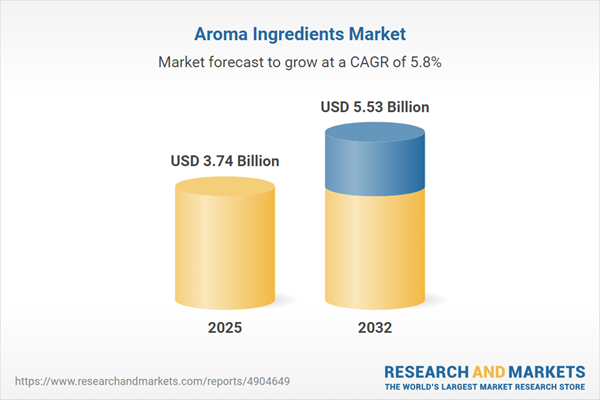Speak directly to the analyst to clarify any post sales queries you may have.
The aroma ingredients market is transforming as businesses adapt to sustainability demands, regulatory shifts, and evolving supply strategies. Industry leaders face an imperative to align operations and product innovation with changing technical expectations and global standards.
Market Snapshot: Aroma Ingredients Market Outlook 2024–2032
The aroma ingredients market is forecast to reach USD 5.53 billion by 2032, rising from USD 3.53 billion in 2024 and USD 3.74 billion in 2025. Growth is fueled by sustained demand from fragrance, personal care, and food and beverage producers. Companies are investing in optimizing sensory performance and production efficiency to satisfy diverse customer requirements. The adoption of scalable manufacturing, balanced sourcing between natural and synthetic ingredients, and investment in regional capabilities supports business agility as regulations, consumer preferences, and competition shift. Demand for aroma ingredients continues to increase as firms enhance portfolios to address a broad array of applications and channel strategies.
Scope & Segmentation: Strategic Structure and Market Drivers in Aroma Ingredients
A detailed understanding of core segments and emerging market drivers empowers senior stakeholders to respond proactively to regulatory mandates and shifting customer needs. This perspective builds a foundation for compliance and competitive advantage in the aroma ingredients market.
- Source: Includes botanicals, animal-derived inputs, fermentation-based components, and petrochemical derivatives. Prioritizing renewable sources is increasingly essential for sustainability and satisfying audit requirements.
- Form: Gels, liquids, solids, and powders deliver manufacturing versatility, allowing producers to tailor solutions for unique product formulations and diverse end uses.
- Distribution Channel: Traditional retail, supplier-operated digital interfaces, and third-party platforms all expand procurement reach, ensuring market access and supporting supply continuity.
- Application: Aroma ingredients are critical in personal care, household, hygiene, fine fragrance, and a comprehensive spread of food categories, including bakery, dairy, beverages, confectionery, and savory goods.
- Regional Coverage: Sector activity is pronounced in the Americas, Europe, Middle East & Africa, and Asia-Pacific. High demand in countries such as the United States, China, Germany, and Brazil shapes compliance strategies and local procurement models for manufacturers targeting distinct regional opportunities.
- Technology Trends: Innovations such as biotechnological synthesis, green chemistry, microencapsulation techniques, synthetic biology, AI-built product development, and digital sampling are increasingly shaping production, efficiency, and customization capabilities within the market.
- Featured Companies: Leading companies like Aquila Organics Private Limited, Aurochemicals, BASF SE, Bell Flavors & Fragrances, Firmenich SA, Givaudan SA, and International Flavors & Fragrances Inc. are noted for their dynamic supply chains, investment in optimized production networks, and sustained adaptation to evolving demands.
Aroma Ingredients Market: Key Takeaways for Decision-Makers
- Adopting agile sourcing and establishing transparent supply frameworks positions organizations to manage complex global requirements and safeguard continuity as the sector evolves.
- Integrating sustainability throughout procurement practices enhances resilience and ensures the ability to address varied compliance needs in international markets.
- Pursuing advanced manufacturing processes and biotechnological methods accelerates the transition to responsible operations and supports ongoing product development initiatives.
- Utilizing AI and digital tools in research streamlines innovation, makes response to market trends more efficient, and enables prioritization of high-value projects.
- Building robust, cooperative supplier networks secures raw material access and optimizes overall value chain efficiency, significantly reducing operational risk.
- Localizing marketing and procurement strategies strengthens positions in established areas and unlocks opportunities in new geographic markets as consumer expectations and regional dynamics evolve.
Tariff Impact: Navigating 2025 US Tariff Policy Shifts
Changes to US tariff structures have compelled aroma ingredient importers, especially those sourcing petrochemical and botanical components, to reassess their supply chain strategies. Companies are evaluating domestic and regional options to bolster resilience and reduce external disruptions. This evolving regulatory environment makes the establishment of thorough compliance frameworks and effective risk controls fundamental to continued supply stability.
Methodology & Data Sources
This analysis draws from both quantitative and qualitative research, utilizing contributions from trade associations, direct executive interviews, industry publications, and official regulatory sources. Critical findings are corroborated across multiple channels to deliver trustworthy and actionable intelligence for strategic planning.
Why This Report Matters
- Provides benchmarks for companies to measure progress in sourcing, sustainability, and the integration of innovative technologies in the aroma ingredients market.
- Clarifies the impact of new regulations, aiding business leaders in refining cross-border procurement and risk management approaches.
- Supports informed investment and partnership planning in established and newly emerging regions to capitalize on operational and market expansion opportunities.
Conclusion
As the sector adapts to regulatory and market dynamics, leveraging sustainable practices and technology innovation helps businesses maintain agility and strengthen long-term operational resilience.
Additional Product Information:
- Purchase of this report includes 1 year online access with quarterly updates.
- This report can be updated on request. Please contact our Customer Experience team using the Ask a Question widget on our website.
Table of Contents
3. Executive Summary
4. Market Overview
7. Cumulative Impact of Artificial Intelligence 2025
Companies Mentioned
The companies profiled in this Aroma Ingredients market report include:- Aquila Organics Private Limited
- Aurochemicals
- BASF SE
- Bell Flavors & Fragrances
- Bordas S.A.
- Citrus and Allied Essences Ltd.
- De Monchy Aromatics Ltd
- Eternis Fine Chemicals Limited
- Firmenich SA
- Givaudan SA
- Huabao International Holdings Limited
- International Flavors & Fragrances Inc.
Table Information
| Report Attribute | Details |
|---|---|
| No. of Pages | 184 |
| Published | November 2025 |
| Forecast Period | 2025 - 2032 |
| Estimated Market Value ( USD | $ 3.74 Billion |
| Forecasted Market Value ( USD | $ 5.53 Billion |
| Compound Annual Growth Rate | 5.7% |
| Regions Covered | Global |
| No. of Companies Mentioned | 13 |









